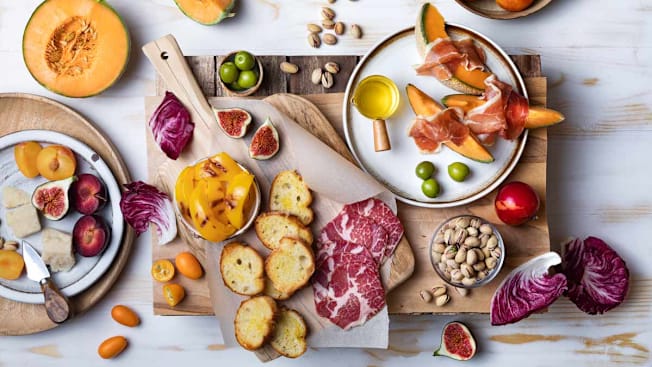How to Maximize Your Meal Leftovers
Cut down on food waste by freezing nuts, making weekly charcuterie boards, vacuum-sealing meats, and following more smart tips

It never fails: Two or three days after purchasing produce and herbs from Trader Joe’s, my spinach wilts and green beans turn sad and soggy. I meal plan and shop once weekly, expecting that what I buy on Sunday will make it to Thursday night’s one-pot spaghetti with artichokes and tomatoes. When it doesn’t, my Dinner Plan B has to kick in (and who has time for that?), but more importantly, I feel like I’m watching money drain from my bank account.
According to the 2025 second-annual Wells Fargo Money Study, 76 percent of Americans are cutting back on spending, up from 67 percent in 2024. The costs for eating out and food delivery are reportedly “higher than expected”—90 percent report sticker shock on eating out; actual costs average 74 percent higher than expected. It’s no surprise that people are focused on finding ways to save money at the grocery store and at home. We’re here to help you cut down on food waste with these smart tips for maximizing produce, herbs, leftovers, and other foods.
1. Meal Plan and Reuse Ingredients
Planning your week’s meals ahead of time helps you eat healthy on a budget and save money. It also allows you to envision ways you can reuse perishable items for more than one meal to ensure they don’t spoil before you have a chance to cook them.
2. Don’t Discard Bones
There are creative ways to reuse nearly every part of a whole chicken or turkey to save money. “I save the bones from roasted or cooked chicken, freeze them, and later use them to make homemade bone broth,” Joanne Mosconi, a trained chef and author of “The Chef of Greenwich Village,” tells CR. “It’s a great way to get another nourishing meal out of what would otherwise be discarded.” Mosconi’s simple bone broth recipe can be found here. You can also freeze bone broth in small cup portions and remove one at a time to use it when needed.
3. Grow Your Own Herbs
Even if you don’t boast the greenest thumb, a countertop indoor herb garden is relatively easy to maintain and lets you pick the herbs you need when you need them. This helps eliminate the inevitable waste that occurs when you buy a huge portion of cilantro, only to use it to top off one night’s meal.
4. Preserve Herbs in Creative Ways
If you aren’t going to use them right away, some ideas to preserve fresh herbs before they wither away include dehydrating them to make powdered herbs. Ground spices can stay flavorful for one to three years, and whole spices can last three to four years. You can also infuse herbs in olive oil or butter, freeze them in airtight containers (more about safe storage in a minute), and pop them into the blender or food processor to whip up delicious sauces.
“When I buy fresh basil, I often turn it into pesto right away and freeze it in small containers,” Mosconi says. “This way, I always have vibrant, homemade pesto ready for pastas, sandwiches, and more—and nothing goes to waste!”
5. Add Last Night’s Leftovers to Today’s Lunch
Make a frittata using leftover veggies, toss leftover roasted chicken into today’s chicken salad, add leftover steak to tacos and flatbread pizzas, and combine rice, veggies, and eggs in a wok to make fried rice from last night’s meal. Be careful with leftover rice, which should be stored in a sealed container for only three to four days in the fridge and then reheated to a temperature of at least 165° F to kill Bacillus cereus and other bacteria.
6. Use Leftovers in Time
According to James E. Rogers, PhD, director of product and food safety research and testing at Consumer Reports, leftovers should be put into the fridge within 2 hours or as soon as possible to reduce bacterial growth, and it’s important to ensure the fridge is at the proper temperature. Cooked leftovers are good for about three to four days in the fridge, Rogers says. After that, their safety and flavor can suffer, so plan to reuse yours sooner rather than later.
7. Make a Charcuterie Board With Leftover Ingredients
Clear out your fridge before grocery shopping day and take stock of all of the items you’ll need to toss soon. Use them to make a fun charcuterie board using carrots, celery, peppers, fruits that you haven’t had a chance to enjoy, cheeses, cold cuts, hummus, crackers, and olives. Place everything on a cutting board and serve it family style. Not only does it make for an unexpected and fun dinner (my kids squeal when they find out it’s charcuterie night), but there will be no pots and pans to wash up.
8. Pack Fresh Produce in Vacuum Food Bowls
Vacuum food bowls use a vacuum seal to remove oxygen from foods, helping them stay fresh longer. CR tested three popular vacuum food bowls and found that one set preserved strawberries, cherry tomatoes, and spinach for 10 days. This is all the more reason to remove produce from its original packaging and transfer it to these bowls.
9. Vacuum-Seal Foods That Are Likely to Spoil
Don’t just freeze expensive steak and other meats; use a vacuum sealer to extract air from bags and create an airtight seal around foods. Fresh bread and vegetables can also be vacuum-sealed to prevent freezer burn and make it more likely you’ll use those ingredients in the future and not toss them.
10. Swap Rice for Potatoes
According to a CR article about wasting less in the kitchen, swapping rice for potatoes as side dishes or part of your main meal can save a family of four $197.81 by the end of the year. A trusty rice cooker can help speed up the process of getting dinner on the table.
11. Freeze Foods You Would Never Consider Freezing
My mother recently told me she eats half an avocado every day for lunch and freezes the other half. “It thaws out beautifully,” she said. If brushed with lemon/lime juice, wrapped tightly, and frozen, browning is minimized, though texture softens. Her tip got me thinking about other foods we should freeze to save money. Amy Keating, a registered dietitian at CR, advises freezing the following foods.
• Cheese: “If you have a lot of extra hard cheeses like cheddar or parmesan, you can grate them and freeze and use them for cooking or topping dishes (pull out as you need and they will thaw very quickly on a plate),” Keating says. “I find that because the structure can change a bit, it is best to freeze hard cheese for future use in cooking, where I’ll be melting the cheese (mac and cheese or on top of chili).” Keating says you can freeze a block of hard cheese, but it might not look as good or have the same texture as fresh cheese for something like a cheese board. According to FoodKeeper, from the Department of Agriculture, hard cheese frozen from the date of purchase can last six months.
• Cooked rice and grains: According to Keating, you can flash freeze cooked rice and other grains in a single layer on a plate or tray prior to putting them in a zip-top bag, and they will be easier to portion out frozen. The USDA recommends keeping cooked rice and grains in the freezer for three to four months for best quality.
• Day-old pizza: “A single slice heats up really well and gets nice and crispy heated in a frying pan on low-medium heat with a cover on top,” Keating says.
• Nuts and seeds: If it takes you a while to get through a whole package of nuts or seeds, Keating says they can start to taste rancid (stale) from exposure to oxygen. Freezing them (for up to six months, although USDA FoodKeeper doesn’t specify) helps maintain their fresh taste.
• Garlic: Since we can never have too much minced garlic, another great tip is to buy whole cloves of garlic, peel them, break them down in a food processor, and then put them in zip-top freezer bags. Roll the bags and use a rolling pin if needed to flatten them. Freeze the bags flat.
12. Know Which Frozen Foods Are Worth Buying
Spending a little more time browsing the frozen food section of your grocery store may help you save money, but experts told CR that single-ingredient frozen foods are healthier than pre-prepared frozen entrées, foods with sauces, breakfast sandwiches, and frozen pizza. Good frozen food choices include fruits that are free of added sugars, vegetables (without added sauces), and whole grains and beans that contain less than 350 mg of sodium per 1-cup serving.
13. Organize Your Fridge
According to the USDA, a family of four loses $1,500 each year to uneaten food. You can’t use what you can’t see—if your fridge isn’t organized, you could be missing out on perfectly fresh produce or restocking your shelves with condiments you already have. CR recommends organizing your fridge by placing produce that wilts in the high-humidity fridge drawer and items that can rot in the low-humidity drawer. Store ethylene-producing fruits such as apples, avocados, and pears separately because, as they ripen, they emit ethylene gas that can cause nearby produce to ripen more rapidly.
Label leftovers with dates and stack them so that you use them in the right order before they spoil. Store meats, poultry, and fish on the bottom fridge shelf (which is the coldest), and don’t store dairy in the compartment inside the door, which is the warmest spot in the fridge. The same is true for eggs, which are safe for three to five weeks in the fridge, but should be stored in their original carton in the coldest part of your fridge (at 40° F or colder) and never in the fridge door.




















